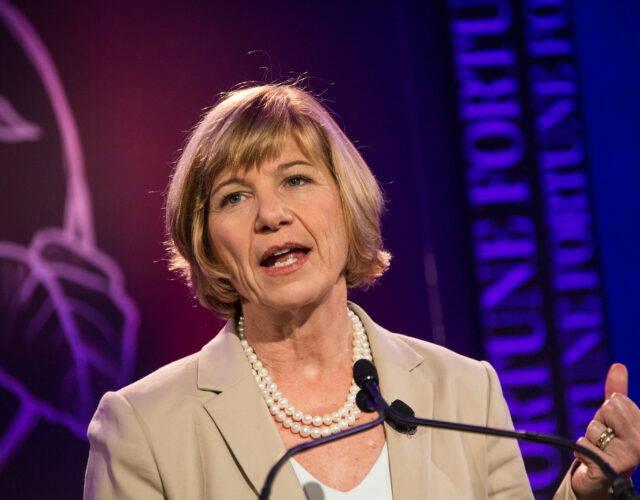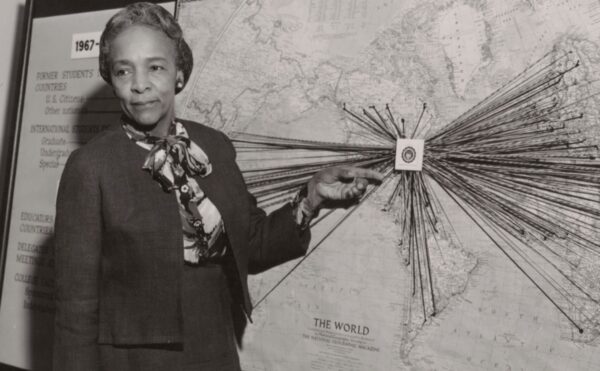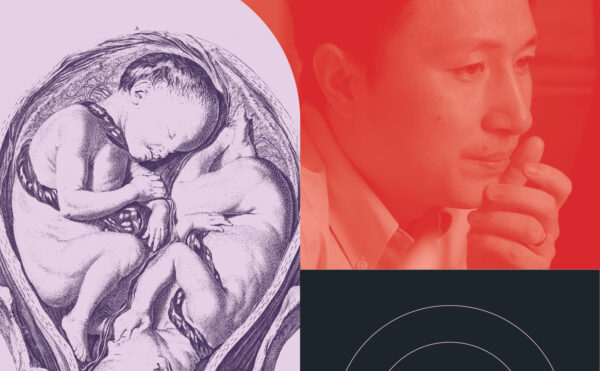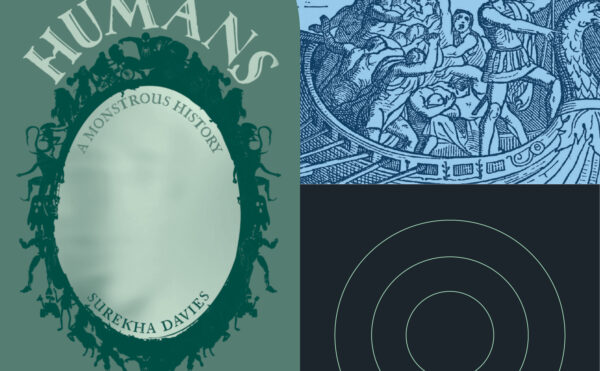Over the next several weeks, Distillations will be talking to people who have special insight into the coronavirus crisis—biomedical researchers, physicians, public health experts, and historians.
In this episode, we speak with Sue Desmond-Hellmann, an oncologist who worked with HIV patients in San Francisco in the 1980s during the HIV/AIDS epidemic. She was also the CEO of the Bill & Melinda Gates Foundation up until December 2019. Desmond-Hellmann tells us about her experiences working as a doctor during the HIV/AIDS epidemic and as a CEO of the Gates Foundation during the Ebola pandemic. She also discusses what we learned from HIV and Ebola that can help us in fighting COVID-19.
Credits
Hosts: Alexis Pedrick
Senior Producer: Mariel Carr
Producer: Rigoberto Hernandez
Researcher: Jessica Wade
Image by Krista Kennell/Fortune Most Powerful Women Summit
Transcript
Alexis: Hello and welcome to Distillations. I’m one of your cohosts, Alexis Pedrick.
In response to the coronavirus pandemic we’ve launched a brand-new series focused entirely on COVID-19. Over the next several weeks we’ll be bringing you interviews with people working at the heart of the crisis: including biomedical researchers, physicians, and public health experts.
For this episode we talked to Sue Desmond-Hellmann, an oncologist who worked with cancer patients in San Francisco during the HIV epidemic in the 1980s. She was the president of product development at Genentech, one of the largest biotech companies in the world. And up until December of 2019 she was the CEO of the Bill and Melinda Gates Foundation. Much of their work is focused on infectious diseases—so the COVID-19 pandemic is right in their wheelhouse. We spoke with Sue to get her perspective on the crisis.
Alexis: So first of all, thank you so, so much for doing this. I know there’s a lot going on, and I am sure you’re super busy. So the fact that you could give us the time is fantastic.
Sue: Sure.
Alexis: You know, your work has put you in the center of all this. I mean, between cancer research and HIV research, not to mention all the work with the Gates Foundation and sort of thinking globally. But how has that informed your perspective of this epidemic?
Sue: Oh, in every way. To start with the—and I think this is true for so many people. Those of us who were in training, and literally I finished medical school in 1982—HIV was first described; it wasn’t called HIV then in 1981. And so being on the front lines, and I don’t think it was as intense. I’m sure it wasn’t as intense as it is today, but my husband, who’s an infectious disease doctor, and I—we were in a study where our blood was drawn to see if we had acquired AIDS as caregivers. And so that intensity of experience where there’s so much uncertainty, you don’t know what’s going to happen.
The patients are so very, very sick, and dying in large numbers, brings me back to those days where it just was really, really frightening. It was frightening and uncertain. But then if you fast-forward to seeing what happened during Ebola, seeing what happened during Zika, and looking at SARS and MERS and working with Bill Gates, who has been pushing all of us to be ready for something much scarier than Ebola.
And the novel coronavirus fits the bill. It’s spread through respiratory. It’s most difficult thing in many ways is the ability to spread it when you are asymptomatic or presymptomatic. And so that brings forward something that I think few of us really thought about because Ebola, when you’re sick, you’re sick.
Alexis: Yes, there’s no doubt.
Sue: You’re physically sick. Yeah. There’s very little doubt when you have Ebola. When you have early novel coronavirus, you can look just like, you know, your average person.
And so these pictures in the airports or other places of people having their temperature screened, it’s estimated only about half of people and maybe less who have the novel coronavirus have a fever.
This is rough, but I definitely feel like it’s brought together a lot of aspects of pandemic preparedness, infectious disease, vaccinology, product development, a lot of things that I’ve been around and talking about and working on for a long time.
Alexis: That makes complete sense. I mean, it sort of leads into my next question, which was really, you know, what has impressed you about science’s response to this pandemic? Or frankly, what has worried you as we are also all in this period of worry and anxiety and fear?
Sue: Well, I’ll start with the good news. The good news is that—and take vaccines as an example, vaccines and therapeutics—the life sciences community from the very start of having the sequence for the virus has collaborated; has pushed themselves to as safely as possible go as fast as possible; has looked at every way possible to push how quickly we can get a vaccine or a therapeutic, starting with repurposed drugs like remdesivir.
So I think on the vaccine and therapeutic side I could not have asked for more from the entire life sciences community, including the FDA and NIH. Everybody involved, I think, has just exceeded what you would call expectations.
Now that doesn’t mean—remdesivir is not a cure, and we don’t have something that blows you away on the therapeutic side. Bu there’s many more medicines in testing. And in the vaccines I think people are doing a very good job so far of looking hard at how quickly we can go while still being safe.
There are two areas on the science front that I am most disappointed in. One is on the diagnostics front. It’s just, and you know, we’ve serially underinvested in diagnostics, but I also think we just lack the right words. I mean, I know if somebody says that this is for a therapeutic not yet proven.
We have a vocabulary and a way of operating and a lot of well-funded companies. In diagnostics we tend to have underfunded academic labs. We don’t readily differentiate between what’s a research diagnostic and a definitive, believable diagnostic. We lack reagents. And so, I think, in the diagnostic space, I would, you know, I hope there’ll be a call for an upgrading of investment, of nomenclature, vocabulary, of toolkit.
So on diagnostics we need to do better. And the other one, to my surprise, because I’ve spent a lot of time around it at Gates Foundation, is the whole aspect of modeling.
Alexis: I’ve read … I’ve heard a lot about this.
Sue: Yeah, your husband’s a math teacher, so you know that. But being mathy is not, it’s not a genetic thing that you’re born being mathy.
You have to learn; you have to actually understand what a confidence interval is. You have to understand the difference between an estimate or a model or a prediction and truth. And just yesterday the Institute for Health Metrics and Evaluation updated their model on the estimated number of deaths from COVID-19 in the U.S., and it was nearly double. And it kind of scared people. But the model is as good as the inputs that go into the model. And when a model changes, it doesn’t mean more people died. It means that the inputs of what they put in—social distancing, other aspects—are different than the last model.
And so I do think from both an education and a communication standpoint, we have some work to do on the modeling front.
Alexis: Right, right. I mean, I think it’s interesting in that it’s—we’re seeing this happen in real time, right? I mean we’re a history organization, and so, you know, we talk a lot about science past tense, and we talk a lot about sort of like, you know, understanding the current moment, but like looking through the lens of history. But this is happening in real time. So there’s also, I think, a lot that’s hard for people I think to wrap their heads around.
Sue: It’s absolutely true. And I think the opportunity for all of us is to learn from what we’re going through and to make ourselves more informed citizens. You know, democracy requires an educated population. And that’s the other thing about the diagnostics and the modeling is, because we’re six months away from a national election, these same things can be used not for science but actually for politics. And so it requires people to kind of steel themselves and to be really cautious and thoughtful about what you believe and how you’re informed.
Alexis: From your perspective what role does public understanding of science sort of play in dealing with an epidemic like this?
Sue: The public understanding and even more importantly, public trust, are the essential elements of fighting a pandemic. Pandemics are frightening. I actually, I had just become the CEO of the Gates Foundation when Ebola happened. And I was shocked at how terrified everyone was.
It was sort of like we had stepped in the middle of a horror movie and just calling something, I mean, Ebola was described as a hemorrhagic fever. Doesn’t that sound terrible? It was just …
Alexis: Yeah.
Sue: Frightening. Frightening, frightening. So, and the novel coronavirus COVID-19 is scary. It’s scary.
But you know, the thing that all humans have in common is they want to protect themselves and their family. And so I think that scientists have to go back to basic principles. We all want to protect ourselves and our family. We all need to have the information that’s required to do that, and it needs to be delivered in ways that are appropriate for us.
And so there’s a movement afoot—and I’m sure you know about it in your org[anization]—to do, for scientists to do a better job of informing and communicating to the public in everything we do. And that starts with good science education in schools, but it doesn’t end as you get older, and it’s not boring and it’s not dry. It’s actually interesting and exciting.
Alexis: Absolutely.
Sue: But I mentioned modeling before because one of the critical aspects of informing the public is trust, and one of the challenges is pandemics. We use predictions, we use models, and we have to change what we say when the data changes. And so when you say on one day—and here’s a good example with COVID-19 that I think was unfortunate—my read is that CDC and the federal government were very worried about the public using masks and buying up all the masks when they were very much needed and in short supply for health care providers.
And so discouraging people from using masks that, “you didn’t need it, or it wouldn’t help,” I think was the wrong message. Saying, look, don’t buy up those masks because we need them for health care providers who need them more, that would have been valid. I think actually people would understand that. But now that we’re pushing people to wear masks, it’s become kind of political. And I think part of how it becomes political is a lack of trust. “Well, you told us we didn’t need it.”
And so what I pushed myself to do in the middle of tough things like this is to be comfortable saying, I don’t know. Here’s my best estimate, but I actually don’t know the answer to that.
I’ll give an example. I don’t know if there will be a safe and effective vaccine. I don’t know particularly if we can have a vaccine as fast as the companies and the academics are trying to have one. And god love them, I hope they’re right, but I don’t know that because the fastest ever was a mumps vaccine in four years, and now we’re trying for 12 to 18 months.
So it’s okay to say, I don’t know. And I don’t know because we don’t—we’ve not tested enough people to know that the vaccines are safe and effective yet. And so if you go back to what the public wants to know, the public can accept even hard things. I mean, there’s a lot of history of citizens sacrificing, working hard, doing tough things when you’re straight with them. But that includes sharing uncertainty, and early science—pandemic science—is filled with uncertainty.
Alexis: Right? That is, yes. Yes. And I think, you know, we were always trying to sort of pull back that curtain and help people see that that’s always a part of the science. It’s just not the part we see, right? We typically get it, Oh, well, here’s the thing that’s all packaged and it makes sense and it’s done. And we just kind of assume that you start with a what-if and then you descend pretty quickly to here’s the answer. And so that’s not the way it works. And so again it is really interesting sort of seeing this play out in real time.
Sue: Exactly. Exactly. And look, I think it’s also really interesting to think about how we all, as the community of scientific leaders, get better at this, you know? I think it’s good to be humble and understand where we’ve done a good job and where things haven’t worked out so well. I’m in California right now, and I think in Northern California and specifically San Francisco, I feel like the staying at home and the communication around what’s going on has been excellent.
It’s, I mean, people are treated like grownups. They’re given the information that they need. It’s hard—especially as it gets nicer.
Alexis: Yes, absolutely.
Sue: But you feel like you’re doing your civic duty.
Alexis: Right? Absolutely. And that is, you know, that, I think you’re right, that sort of challenge across the board of how do we communicate this? We had a talk with the curator of the Mütter’s exhibit Spit Spreads Death a couple of weeks ago. And that was one of the things she was echoing too, the importance of sort of truth in reporting to people through this process: that like if you took anything from the 1918 pandemic, she said, I hope it’s that—that we need to be truthful and straightforward with people.
Sue: Totally agree.
Alexis: So that is definitely I think top of mine. I just want to say again thank you so, so much. Is there anything at this point that we haven’t chatted about that, you know, you want to make sure we think about or we share with the people who listen to us?
Sue: Yeah. Actually, I remember at the very beginning hearing from the surgeon general and head of CDC. Washing your hands, not touching your face, and keeping at least six feet distance from others around you remain extremely effective ways to keep yourself safe. And wearing a mask when you are—it’s hard to keep that distance like in a grocery store or pharmacy—and in wearing the mask you’re protecting others. So the basics are really effective. And don’t forget that.
Alexis: I think, honestly, that’s perfect advice for us to sign off with. I really appreciate it. Thank you so, so much.
Alexis: Thanks for listening to this episode of Pandemic Perspectives. We’ll be bringing you more interviews from all sides of this crisis so stay tuned and watch your feeds. As always, you can find all of our episodes plus transcripts and show notes at distillations.org.
And you can find tons of educational resources on our website at sciencehistory.org/learn.
The Science History Institute remains committed to revealing the role of science in our world. Please support our efforts at sciencehistory.org/givenow.
Alright, that’s all. Goodbye.




